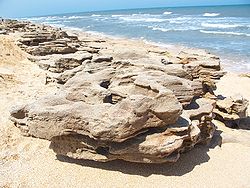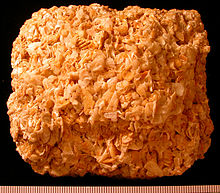- Coquina
-
- For the variety of clam, see Donax .
 Coquina outcropping on the beach at Washington Oaks State Gardens, Florida
Coquina outcropping on the beach at Washington Oaks State Gardens, Florida
Coquina (
 /koʊˈkiːnə/; Spanish: "cockle") is a sedimentary rock that is composed either wholly or almost entirely of the transported, abraded, and mechanically sorted fragments of the shells of either molluscs, trilobites, brachiopods, or other invertebrates. For a sediment to be considered to be a coquina, the average size of the particles composing it should be 2 mm or greater in size. Coquina can vary in hardness from poorly to moderately-cemented. The term "coquina" is derived from the Spanish word for cockleshells or shellfish.[1][2] Incompletely consolidated and poorly cemented coquinas are considered grainstones in the Dunham classification system for carbonate sedimentary rocks. [3] Well-cemented coquinas are classified as biosparites according to the Folk classification of sedimentary rocks.[4]
/koʊˈkiːnə/; Spanish: "cockle") is a sedimentary rock that is composed either wholly or almost entirely of the transported, abraded, and mechanically sorted fragments of the shells of either molluscs, trilobites, brachiopods, or other invertebrates. For a sediment to be considered to be a coquina, the average size of the particles composing it should be 2 mm or greater in size. Coquina can vary in hardness from poorly to moderately-cemented. The term "coquina" is derived from the Spanish word for cockleshells or shellfish.[1][2] Incompletely consolidated and poorly cemented coquinas are considered grainstones in the Dunham classification system for carbonate sedimentary rocks. [3] Well-cemented coquinas are classified as biosparites according to the Folk classification of sedimentary rocks.[4]Coquinas accumulate in high-energy marine and lacustrine environments where currents and waves result in the vigorous winnowing, abrasion, fracturing, and sorting of the shells, which compose them. As a result, they typically exhibit well-developed bedding or cross-bedding, close packing, and good orientation of the shell fragments composing them. The high-energy marine or lacustrine associated with coquinas include beaches, shallow submarine raised banks, swift tidal channels, and barrier bars.[4][5]
Contents
Composition and distribution
Coquina is mainly composed of mineral calcite, often including some phosphate, in the form of seashells or coral. It is found in surface exposures along the east coast of Florida from St. Johns County to Palm Beach County. It may occur up to 20 miles inland from the coast in the sub-surface. It is found as far north as Fort Fisher, North Carolina. It has also been formed in the South Island of New Zealand, where it outcrops in a disused quarry near Oamaru. The Oligocene deposits here are composed primarily of very well preserved brachiopod shells, in a matrix of brachiopod, echinoid, and bryozoan detritus and foraminifera.
History and use
Occasionally quarried or mined and used as a building stone in Florida for over 400 years, coquina forms the walls of the Castillo de San Marcos, Saint Augustine. The stone makes a very good material for forts, particularly those built during the period of heavy cannon use. Because of coquina's softness, cannon balls would sink into, rather than shatter or puncture, the walls of the Castillo de San Marcos.
When first quarried, coquina is extremely soft. This softness makes it very easy to remove from the quarry and cut into shape. However, the stone is also at first much too soft to be used for building. In order to be used as a building material, the stone is left out to dry for approximately one to three years, which causes the stone to harden into a usable, but still comparatively soft, form.
Coquina has also been used as a source of paving material. It is usually poorly cemented and easily breaks into component shell or coral fragments, which can be substituted for gravel or crushed harder rocks. Large pieces of coquina of unusual shape are sometimes used as landscape decoration.
Because coquina often includes a component of phosphate, it is sometimes mined for use as fertilizer.
Notable exposures of coquina
- Washington Oaks State Gardens, Flagler County, Florida
- Blowing Rocks Preserve (and along Country Club Road), Palm Beach County, Florida
- Shell Beach, Shark Bay, Western Australia
Coquina in architecture
- Castillo de San Marcos, St. Augustine, Florida
- Fort Matanzas National Monument, Florida
- Bok Tower, Florida
- North Carolina Aquarium at Fort Fisher, displays a "Coquina Outcrop Touch Pool"
References
- ^ U.S. Bureau of Mines Staff (1996) Dictionary of Mining, Mineral, & Related Terms. Report SP-96-1, U.S. Department of Interior, U.S. Bureau of Mines, Washington, D.C.
- ^ Neuendorf, K.K.E., J.P. Mehl, Jr., and J.A. Jackson, J.A., eds. (2005) Glossary of Geology (5th ed.). Alexandria, Virginia, American Geological Institute. 779 pp. ISBN 0-922152-76-4
- ^ Dunham, R.J. (1962). Classification of carbonate rocks according to depositional texture. In Ham, W. E.. Classification of carbonate rocks. American Association of Petroleum Geologists Memoir. no. 1, pp. 108-121.
- ^ a b Folk, R.L. (1980) The Petrology of Sedimentary Rocks. Austin, Texas, Hemphill Publishing Company. 182 pp. ISBN 100914696149
- ^ Scholle, P.A., D.G. Bebout, and C.H. Moore (1983) Carbonate Depositional Environments. Memoir no. 33. Tulsa, Oklahoma, American Association of Petroleum Geologists. 708 pp. ISBN-13 978-0891813101
See also
External links
Categories:- Sedimentary rocks
- Limestone
Wikimedia Foundation. 2010.


